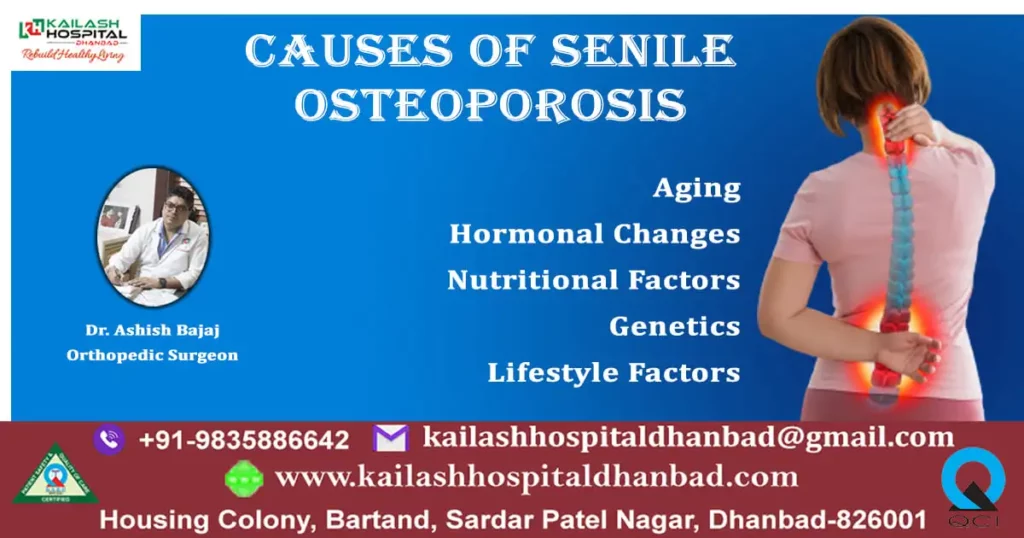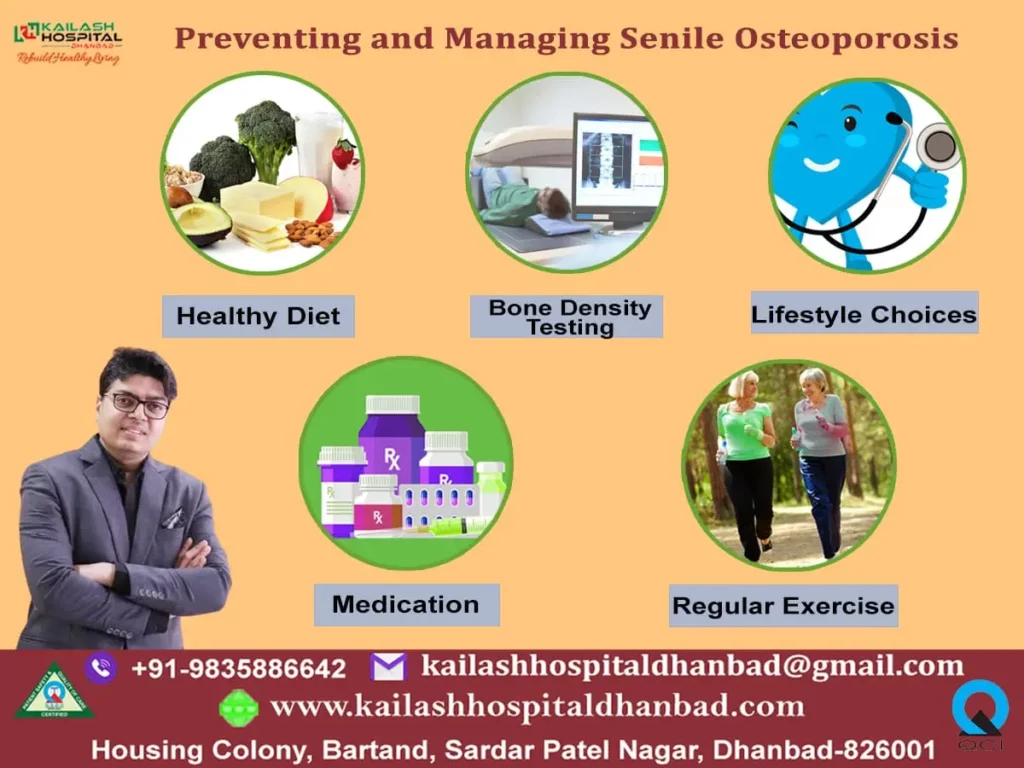
Table of Contents
A prevalent bone condition that affects millions of people worldwide is osteoporosis. It is characterised by a decrease in bone density and quality, making bones fragile and more susceptible to fractures. While osteoporosis is often discussed as a single condition, it actually encompasses several different types, each with its own unique characteristics and risk factors.
In this blog post, we will explore the various types of osteoporosis to provide a better understanding of this condition.
Types of osteoporosis:
1. Primary Osteoporosis
Primary osteoporosis is one of the most common types of osteoporosis and typically occurs as a result of the natural ageing process. It can be further divided into two sub types:
- Postmenopausal Osteoporosis: This type primarily affects women after menopause due to a decrease in oestrogen levels, which plays a crucial role in maintaining bone density.
- Senile Osteoporosis: Senile osteoporosis occurs in both men and women as they age, usually after the age of 70. It is a result of the gradual breakdown of bone tissue that occurs with ageing.
2. Secondary Osteoporosis
Medications or underlying medical disorders are the primary cause of secondary osteoporosis. The following are some typical causes of secondary osteoporosis:
- Medications: Certain drugs, such as long-term corticosteroid use, can weaken bones and lead to osteoporosis.
- Medical Conditions: Conditions like rheumatoid arthritis, Crohn’s disease, celiac disease, and hyperthyroidism can increase the risk of secondary osteoporosis.
- Hormonal Disorders: Hormonal imbalances, such as hyperparathyroidism or low levels of sex hormones, can contribute to the development of osteoporosis.
- Nutritional Deficiencies: Inadequate intake of calcium and vitamin D can weaken bones and increase the risk of osteoporosis.
3. Idiopathic Juvenile Osteoporosis
This type of osteoporosis occurs in children and adolescents for no apparent reason, hence the term “idiopathic.” It can be challenging to diagnose and manage, but early intervention and proper nutrition are crucial for affected individuals.
4. High Bone Turnover Osteoporosis
High bone turnover osteoporosis is characterised by a rapid breakdown and rebuilding of bone tissue. It is often associated with conditions like hyperthyroidism and hyperparathyroidism, where hormonal imbalances disrupt the normal bone remodelling process.
5. Regional Osteoporosis
Regional osteoporosis refers to the localised loss of bone density in a specific area of the body, often due to injury or disuse. For example, if you break a bone and it is immobilised for an extended period, the surrounding bones may become weaker due to lack of weight-bearing exercise.
6. Drug-Induced Osteoporosis
As mentioned earlier, certain medications, particularly long-term use of corticosteroids, can lead to drug-induced osteoporosis. It is essential for individuals taking such medications to work closely with their healthcare providers to monitor bone health and implement preventive measures.
7. Senile Osteoporosis
Senile osteoporosis, also known as age-related osteoporosis, is a type of osteoporosis that primarily affects individuals over the age of 70. As people age, bone density naturally decreases. However, in senile osteoporosis, this loss of bone density is accelerated, leaving bones brittle and prone to fractures.
The term “senile” in senile osteoporosis refers to the age group it predominantly affects, but it’s essential to remember that not everyone in this age range will develop the condition.
Causes of Senile Osteoporosis:
Several factors contribute to the development of senile osteoporosis:

- Ageing: The primary cause of senile osteoporosis is the natural ageing process. As we get older, our bodies’ ability to build and maintain bone density decreases.
- Hormonal Changes: Changes in hormonal levels, particularly a decrease in oestrogen in women after menopause and a decrease in testosterone in men, play a significant role in bone loss.
- Nutritional Factors: Inadequate intake of calcium and vitamin D throughout life can weaken bones and increase the risk of senile osteoporosis.
- Genetics: Family history of osteoporosis can increase the likelihood of developing the condition.
- Lifestyle Factors: Sedentary lifestyle, smoking, excessive alcohol consumption, and a lack of weight-bearing exercises can all contribute to bone loss.
Risk Factors:
Certain risk factors make some individuals more susceptible to senile osteoporosis:
- Gender: Women are generally at a higher risk than men, especially after menopause.
- Age: Your risk increases as you get older.
- Family History: A family history of osteoporosis can increase your risk.
- Hormonal Changes: Early menopause, low body weight, and certain medical conditions can impact hormone levels and bone health.
- Medications: Long-term use of certain medications, such as corticosteroids, can weaken bones.
Preventing and Managing Senile Osteoporosis:
While senile osteoporosis is a natural part of ageing, there are steps you can take to prevent it or manage its progression:

- Diet: Ensure a balanced diet rich in calcium and vitamin D. Leafy greens, dairy products, and fortified foods are all great sources.
- Regular Exercise: Engage in weight-bearing exercises like walking, dancing, and weightlifting to help maintain bone density.
- Lifestyle Choices: Quit smoking, limit alcohol consumption, and maintain a healthy body weight.
- Medication: In severe cases, healthcare providers may recommend medications to increase bone density.
- Bone Density Testing: Regular bone density scans can help identify bone loss early, allowing for proactive management.
Osteoporosis is a complex bone disorder with various types, each influenced by distinct risk factors and causes. Understanding these different types is crucial for effective diagnosis, treatment, and prevention.
If you are at risk of developing osteoporosis or have concerns about your bone health, consult a healthcare professional for personalised guidance and recommendations. Maintaining a healthy lifestyle, including a balanced diet, regular exercise, and bone-healthy habits, is essential in reducing the risk of osteoporosis, regardless of its type.
What is Bone Density Test ?
Bone density testing determines whether you have osteoporosis – a disorder in which bones become more brittle and more likely to break. The test uses X-rays to measure how many grams of calcium and other bone minerals are filled in a section of bone. The bones most commonly tested are those of the spine, hip, and sometimes the forearm.
What food to avoid for osteoporosis?
Avoiding excess salt, alcohol and sugar may be beneficial for people suffering from osteoporosis. Additionally, people should make sure to consume plenty of foods containing calcium and vitamin D



